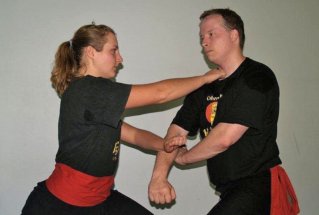Read about kung fu leopard style using lightening-fast foot work and distinctive hand techniques combined to produce power and strength to overcome opponents.

Leopard is one of the five Shaolin kung fu animals. It was developed by Mot, a Choy Li Fut expert in the Fujian province. Although it is a southern style, it also has elements of northern styles. The leopard provides a balance between the raw strength and power of the tiger; and the agility and accuracy of the crane. The leopard is smaller than the tiger and hence does not share its crushing power. Instead, the leopard relies on its speed and aggression to make up for this. Like tiger, it is generally considered an external style and helps to develop both physical strength and speed. Leopard training leads to conditioning of the skin, tendons, bone and muscle. In contrast to the crane, there is very little internal qi development since this development of qi is promoted though slow and precise training.
Kung Fu Leopard Style Techniques
The leopard favours the use of fast, short range techniques. Instead of using the solid, tense power seen in the tiger, the leopard’s power is generated through looser, whip-like techniques. The twisting of the hips and waist allows for effective generation of power and fast foot work. The leopard style requires the practitioner to show balance, speed, flexibility and agility. Due to the emphasis on speed in this style, leopard is traditionally thought to help develop the practitioner’s fast-twitch muscle fibres. This is the type of muscle fibre which primarily contributes to the explosive bursts of strength and speed characteristic of this style.
The leopard uses an unrelenting series of attacks, whilst generally avoiding the need to block. Instead the forearm is used to deflect an attack while simultaneously executing an attack of its own. By playing down the use of blocks the leopard can be even faster. This is because blocks are inherently slow and require the defender to recognise the attack, intercept it, and then deflect the strike. By using a flurry of attacks, the leopard forces the opponent into a defensive position, leaving very little time for them to attack.
Techniques used in the leopard style include low kicks, elbows and forearm strikes, as well as the use of the distinctive leopard fist (bao chui). The bao chui is formed by bending the four fingers under the hand from the first joint, rather than the knuckles. The thumb is used to brace the fingers. Sufficient pressure must be applied through the thumb in order for this brace to be effective. The smaller size of the bao chui allows the strikes of the leopard to be targeted to softer and weaker parts of the body. These often include the face, throat, ribs and solar plexus. The bao chui can also be targeted at specific dim mak pressure points, much like crane style. The bao chui can be used to rake or crush these targets and is very effective at causing trauma with fast penetrating force. The bao chui can be delivered at a variety of angles, including the lead jab, rear cross and hook punch. The back of the hand can also be used for breaking, as long as sufficient conditioning has been undertaken.
The forward elbow smash uses another characteristic technique used in the leopard style. This technique is short range and can be used to drive though the opponent’s defences, generally targeting weak points, including the less obvious targets such as the side of the knee or the extended elbow. Much like the elbow smash, the knee strike is also employed in short range attacks and is often combined with the elbow smash so as to make defending the attack even more difficult.
While the leopard style mainly focuses on hand strikes and fast foot work, lower kicks can also be incorporated into this style. They will generally target the opponent’s knees or ankles and can be used to either destroy the joints or act as a distraction to open up the opponent to further attacks.
The footwork of this style is one of the key aspects which allow it to be so fast. The leopard style uses quick short stances, which are very stable, to help to produce the strength and balance required. It is this which allows the direction of attack to change quickly and easily. Strong stances allow the generation of tremendous power and force.
Users of the leopard style must ensure that their knuckles and wrists are adequately conditioned in order to avoid self-injury when applying techniques such as the bao chui. This can be done though extensive training with firm sandbags as punching bags; as well as push-ups using knuckles (as opposed to palms).
The kung fu leopard style uses lightening-fast foot work and distinctive hand techniques which are combined to produce power and strength to overcome opponents.
Emma Watson, Kung Fu Golden Lion Student Murrumbeena, Melbourne
